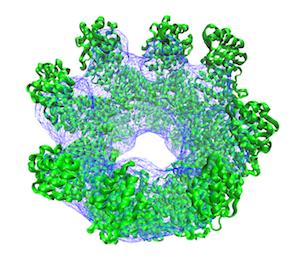X-ray solution scattering is a routine biophysical technique used to determine structure and dynamics of macromolecules in solution. When solution scattering data is interpreted, often with the aid of known atomic models, an improved understanding of the macromolecule’s biological function and properties emerges. The main challenge associated with solution scattering data is the intrinsic lack of information that can be obtained from such data. By using a technique called fluctuation X-ray scattering (FXS), researchers can significantly enhance the information content of the data. This leads to fewer ambiguities in the resulting structural models and a better understanding of the associated biology. As shown in the figure to the right, fluctuation scattering allows a more detailed reconstruction of the shape of macromolecules in solution as compared to rival techniques.
The technique can be performed at state of the art X-ray facilities, such as the SLAC Linac Coherent Light Source (LCLS), at the ALS and other synchrotron facilities. The current understanding of fluctuation scattering theory, optimal data analyses, and model reconstructing practices is limited, while the availability of user facilities on which these experiments can be performed is growing rapidly. The National Institutes of Health have shown interest in and provided important support for the development of FXS by awarding an R01 grant to Dr. Peter H. Zwart, Biophysicist Research Scientist in the Physical Biosciences Division. The funding, $1.7M USD over the next five years, will be used by Dr. Zwart and his team to develop theory and software for the analyses of FXS data. The research, originating from a Laboratory Directed Research and Development effort, will ultimately enable a better understanding of the dynamics of biological systems at the atomic level.





